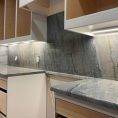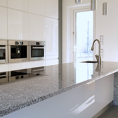Our Fuquay-Varina headquarters showcases the best in countertop design. Experience state-of-the-art technology and craftsmanship with NSD!
Granite is a light-colored igneous rock with grains large enough to be visible with the unaided eye. It forms from the slow crystallization of magma below Earth’s surface. Granite is composed mainly of quartz and feldspar with minor amounts of mica, amphiboles and other minerals. This mineral composition usually gives granite a red, pink, gray or white color with dark mineral grains visible throughout the rock.Granite is the best-known igneous rock. Many people recognize granite because it is the most common igneous rock found at Earth’s surface and because granite is used to make many objects that we encounter in daily life. These include counter tops, floor tiles, paving stone, curbing, stair treads, and building veneer. Granite is used all around us.
Yes, Granite, Quartz and Marble samples are accurate representations of the entire slab
Between 5 and 7 business days from template to installation, depending on whether a slab layout is required.
No more than 3 days from template.
Between 5 and 7 business days from template to installation, depending on whether a slab layout is required.
The weight of granite depends on its density. The average 1 1/4″ thick granite weighs around 18 to 20 pounds per square foot. The darker stones are usually heavier than the lighter stones.
Yes, we will seal your granite countertops upon completion of your installation.
Etching is when products containing lemon, vinegar, alcohol, ammonia or other acids leave dull spots or rings on a stone. Etching is an issue for marble countertops, not for granite.
Marble is a metamorphic rock that forms when limestone is subjected to the heat and pressure of metamorphism. It is composed primarily of the mineral calcite (CaCO3) and usually contains other minerals such as: clay minerals, micas, quartz, pyrite, iron oxides and graphite. Under the conditions of metamorphism the calcite in the limestone recrystallizes to form a rock that is a mass of interlocking calcite crystals. A related rock, dolomitic marble, is produced when dolostone is subjected to heat and pressure.
¾” (2cm) or 1 ¼” (3cm)
Sometimes called “grain in the stone,” “movement” are veins that swirl and change irregularly in granite due to the massive forces at work on it beneath the surface of the earth during the eons it took to form. “Movement” is also affected by trace amounts of other minerals such as hornblende, magnetite, hematite, pyrite, zircon, garnet and corundum.
On granite colors that have a lot of movement, we invite you to come in and we will lay out the templates on your slab. That way you can have certain portions of the slab in certain areas of your countertops.
Yes, we will seal your granite countertops upon completion of your installation.
No, you can do this easily yourself. You can purchase a sealer from us or a supplier of your choice and just follow the directions on the bottle.






